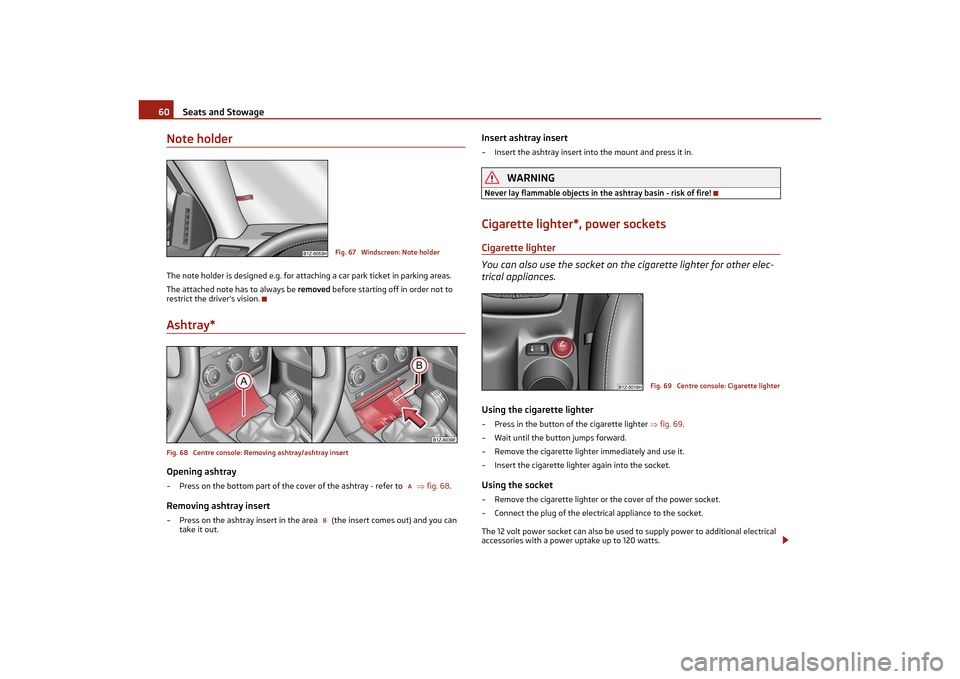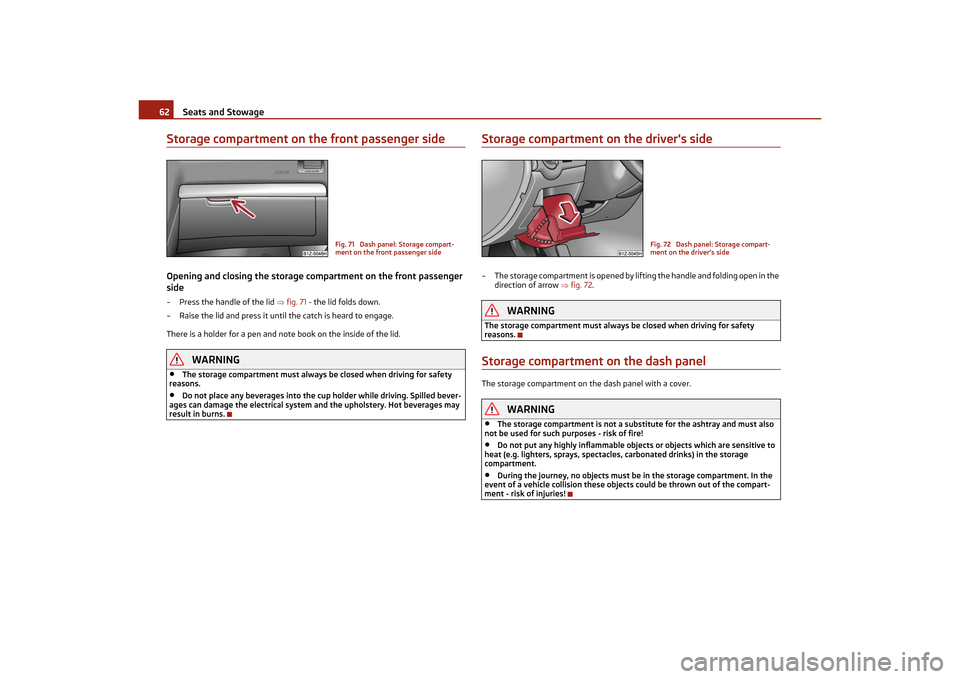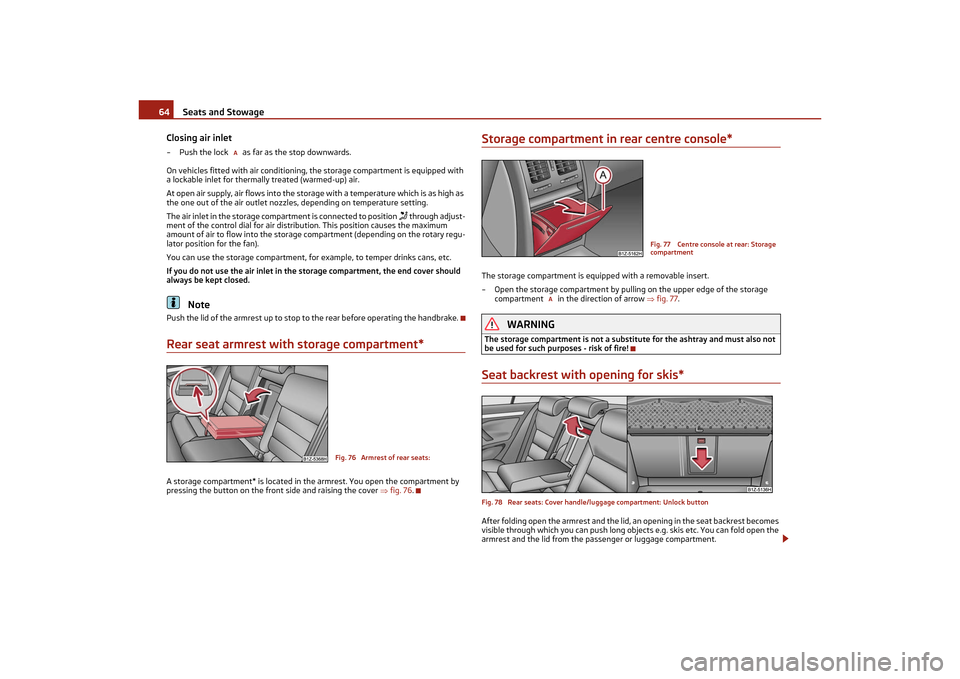2011 SKODA OCTAVIA TOUR warning
[x] Cancel search: warningPage 61 of 183

Seats and Stowage
60
Note holderThe note holder is designed e.g. for attaching a car park ticket in parking areas.
The attached note has to always be removed before starting off in order not to
restrict the driver's vision.Ashtray*Fig. 68 Centre console: Re moving ashtray/ashtray insertOpening ashtray– Press on the bottom part of the cover of the ashtray - refer to fig. 68 .Removing ashtray insert– Press on the ashtray insert in the area (the insert comes out) and you can
take it out.
Insert ashtray insert– Insert the ashtray insert into the mount and press it in.
WARNING
Never lay flammable objects in the ashtray basin - risk of fire!Cigarette lighter*, power socketsCigarette lighter
You can also use the socket on the cigarette lighter for other elec-
trical appliances.Using the cigarette lighter– Press in the button of the cigarette lighter fig. 69 .
– Wait until the button jumps forward.
– Remove the cigarette lighter immediately and use it.
– Insert the cigarette lighter again into the socket.Using the socket– Remove the cigarette lighter or the cover of the power socket.
– Connect the plug of the electrical appliance to the socket.
The 12 volt power socket can also be used to supply power to additional electrical
accessories with a power uptake up to 120 watts.
Fig. 67 Windscreen: Note holder
A
B
Fig. 69 Centre console: Cigarette lighter
s2lk.2.book Page 60 Monday, April 18, 2011 7:41 AM
Page 62 of 183

Seats and Stowage61
Using the system
Safety
Driving Tips
General Maintenance
Breakdown assistance
Technical Data
WARNING
•
Take care when using the cigarette lighter! Not paying proper attention or
incorrect use the cigarette lighter in an uncontrolled manner may result in burns.
•
The cigarette lighter and the power socket also operates when the ignition
is switched off or the ignition key withdrawn. You should therefore never leave
children unattended in the vehicle.Caution
Always use matching plugs to avoid damaging the power socket.
Note
•
Connecting electrical components when the engine is not running will drain
the battery of the vehicle - risk of battery draining!
•
Further information page 146, “Accessories, changing and replacing parts”.
Power socket in the luggage compartment (Combi)– Open the cover of the power socket fig. 70.
– Connect the plug of the electrical appliance to the socket.
You can only use the power socket for the connection of approved electrical acces-
sories with a power uptake up to 120 watts. The vehicle battery will be discharged
in the process if the engine is stationary.
The same remarks apply here as for page 60, “Cigarette lighter*, power sockets”.
Further information page 146, “Accessories, changing and replacing parts”.
Storage compartmentsOverviewYou will find the following storage facilities in your vehicle:
WARNING
•
Please do not place anything on top of the dash panel. Such objects might
slide or fall down when driving (when accelerating or cornering) and may
distract you from concentrating on the traffic situation - risk of accident!
•
Ensure that when driving no objects from the centre console of from other
storage possibilities may get into the footwell of the driver. You would then no
longer be able to apply th e brakes, operate the clutch or accelerator - risk of
accident!
Fig. 70 Luggage compartment: Power
socket
Storage compartment on the front passenger side
page 62
Storage compartment on the driver's side
page 62
Storage compartment on the dash panel
page 62
Storage compartment in front centre console*
page 63
Storage compartment in the front doors
page 63
Front seat armrest with storage compartment*
page 63
Rear armrest with storage compartment*
page 64
Storage compartment in rear centre console*
page 64
Seat backrest with opening for skis*
page 64
Clothes hooks*
page 65
s2lk.2.book Page 61 Monday, April 18, 2011 7:41 AM
Page 63 of 183

Seats and Stowage
62
Storage compartment on the front passenger sideOpening and closing the storage co mpartment on the front passenger
side– Press the handle of the lid fig. 71 - the lid folds down.
– Raise the lid and press it unti l the catch is heard to engage.
There is a holder for a pen and note book on the inside of the lid.
WARNING
•
The storage compartment must always be closed when driving for safety
reasons.
•
Do not place any beverages into the cup holder while driving. Spilled bever-
ages can damage the electrical system and the upholstery. Hot beverages may
result in burns.
Storage compartment on the driver's side– The storage compartment is opened by lifting the handle and folding open in the direction of arrow fig. 72.
WARNING
The storage compartment must always be closed when driving for safety
reasons.Storage compartment on the dash panelThe storage compartment on the dash panel with a cover.
WARNING
•
The storage compartment is not a substi tute for the ashtray and must also
not be used for such purposes - risk of fire!
•
Do not put any highly inflammable obje cts or objects which are sensitive to
heat (e.g. lighters, sprays, spectacles , carbonated drinks) in the storage
compartment.
•
During the journey, no objects must be in the storage compartment. In the
event of a vehicle collision these objects could be thrown out of the compart-
ment - risk of injuries!
Fig. 71 Dash panel: Storage compart-
ment on the front passenger side
Fig. 72 Dash panel: Storage compart-
ment on the driver's side
s2lk.2.book Page 62 Monday, April 18, 2011 7:41 AM
Page 64 of 183

Seats and Stowage63
Using the system
Safety
Driving Tips
General Maintenance
Breakdown assistance
Technical Data
Storage compartment in front centre console*– Press on the bottom part of the storage compartment in the area fig. 73 -
the lid opens.
WARNING
The storage compartment is not a substitu te for the ashtray and must also not
be used for such purposes - risk of fire!Storage compartment in the front doorsA bottle holder is located in the area of the storage compartment for the front
doors.
WARNING
Use the area fig. 74 of the storage compartment only for storing objects
which do not project so that the effe ctiveness of the side airbag is not
impaired.Front seat armrest with storage compartment*Fig. 75 Armrest: Storage compartm ent/cooling of storage compartmentThe armrest is adjustable for height and length.Opening storage compartment– Open the lid of the armrest in the direction of arrow fig. 75 - left.Closing storage compartment– Open the lid up to the stop, then you can fold it downwards.Setting height– First of all fold the lid to the bottom and lift it in the direction of arrow into one
of the 4 fixed positions.Adjusting in forward/back direction– Push the lid into the desired position.Opening air inlet– Pull the lock in upward direction.
Fig. 73 Front centre console: Storage
compartment
A
Fig. 74 Storage compartment in the
front doors
B
AA
s2lk.2.book Page 63 Monday, April 18, 2011 7:41 AM
Page 65 of 183

Seats and Stowage
64
Closing air inlet
– Push the lock as far as the stop downwards.
On vehicles fitted with air conditioning, the storage compartment is equipped with
a lockable inlet for thermally treated (warmed-up) air.
At open air supply, air flows into the storage with a temper ature which is as high as
the one out of the air outlet nozzle s, depending on temperature setting.
The air inlet in the storage compartment is connected to position
through adjust-
ment of the control dial for air distribu tion. This position causes the maximum
amount of air to flow into the storage co mpartment (depending on the rotary regu-
lator position for the fan).
You can use the storage compartment, for example, to temper drinks cans, etc.
If you do not use the air inlet in the storage compartment, the end cover should
always be kept closed.
Note
Push the lid of the armrest up to stop to the rear before operating the handbrake.Rear seat armrest with storage compartment*A storage compartment* is located in the armrest. You open the compartment by
pressing the button on the front side and raising the cover fig. 76.
Storage compartment in rear centre console*The storage compartment is equipped with a removable insert.
– Open the storage compartment by pulling on the upper edge of the storage
compartment in the direction of arrow fig. 77.
WARNING
The storage compartment is not a substitu te for the ashtray and must also not
be used for such purposes - risk of fire!Seat backrest with opening for skis*Fig. 78 Rear seats: Cover handle/luggage compartment: Unlock buttonAfter folding open the armrest and the lid, an opening in the seat backrest becomes
visible through which you can push long objects e.g. skis etc. You can fold open the
armrest and the lid from the passenger or luggage compartment.
A
Fig. 76 Armrest of rear seats:
Fig. 77 Centre console at rear: Storage
compartment
A
s2lk.2.book Page 64 Monday, April 18, 2011 7:41 AM
Page 66 of 183

Seats and Stowage65
Using the system
Safety
Driving Tips
General Maintenance
Breakdown assistance
Technical Data
Opening from passenger compartment– Pull down the armrest of the rear seat at the loop page 52.
– Pull the handle up to the stop in upward direction and fold open the lid down- wards page 64, fig. 78 - left.Opening from luggage compartment– Push the unlock button downwards page 64, fig. 78 - right and fold the lid
(with armrest) to the front.Closing– Fold the cover and the arm rest upwards as far as the stop. The cover must click
into place audibly.
Ensure that the armrest is always locked into place after closing. You can recognise
this on the fact that the red field above the unlocking button of the luggage
compartment is not visible.Clothes hooks*The clothes hooks are located on the middle pillar and on the handle in the head-
liner above each of the rear doors.
WARNING
•
Ensure that any clothes hanging from the hooks do not impair your vision to
the rear.
•
Use the hooks for hanging only light items of clothing and ensure that there
are no heavy or sharp-edge d objects in the pockets.
•
The maximum permissible load of the hooks is 2 kg.
•
Do not use clothes hangers for hanging up items of clothing otherwise this
will interfere with the protecti on offered by the head airbag*.
s2lk.2.book Page 65 Monday, April 18, 2011 7:41 AM
Page 68 of 183

Heating and air conditioning system67
Using the system
Safety
Driving Tips
General Maintenance
Breakdown assistance
Technical Data
HeatingUsing the system
The heating system delivers air into the interior of the vehicle and
warms it as required.Fig. 81 Heating: Control elementsSetting temperature– Turn the control dial fig. 81 to the right in order to increase the tempera-
ture.
– Turn the control dial to the left in order to increase the temperature.Controlling blower– Turn the blower switch into one of the po si ti o ns , 1 to 4, in o rd e r t o sw itc h the
blower on.
– Turn the blower switch into position 0 in order to switch the blower off.
– If you wish to shut off the fresh air su pply, use the button - recirculated air
mode .Control for air distribution– You can adjust the direction of the air flow using the air distribution control
page 66.
Rear window heater– Press button . Further information page 44, “Rear window heater”.
The air inlet in front of the windscreen must be free of ice, snow or leaves in order
to ensure that the heating and ve ntilation systems operate properly.
The heating effect depends on the coolan t temperature. The full heating effect
does not kick in until the engine is run in.
The blower should aways be on to prevent the windows from misting up.
WARNING
You should not leave recirculated air mode on over a longer period of time, as
“stale” air may result in fatigue in the dr iver and occupants, divert your attention
and also cause the windows to mist up. Th e risk of having an accident increases.
Switch recirculated air mode off as soon as the windows begin misting up.
Note
•
The whole heat output will be needed to unfrost the windscreen and side
windows. No warm air will be fed to the footwell. This can lead to restriction of the
heating comfort.
•
The used air streams out through the air removal openings in the luggage
compartment.
AABB
1
C
2
s2lk.2.book Page 67 Monday, April 18, 2011 7:41 AM
Page 70 of 183

Heating and air conditioning system69
Using the system
Safety
Driving Tips
General Maintenance
Breakdown assistance
Technical Data
Recirculated air mode
In recirculated air mode air is sucked out of the interior of the vehicle
and then fed back into the interior.Recirculated air mode prevents polluted ai r outside the vehicle from getting into the
vehicle, for example when driving through a tunnel or when standing in a traffic jam.Switching recirculated air mode on– Press the button . The warning light in the button page 67, fig. 81 goes
out.Switching recirculated air mode off– Once again press the button . The warning light in the button goes out.
The recirculated air mode is switched off au tomatically if the air distribution control
is in position
page 67, fig. 81 . You can also switch recirculated air mode on
again from this setting by re peatedly pressing pushbutton .
WARNING
You should not leave recirculated air mode on over a longer period of time, as
“stale” air may result in fatigue in the driver and occupants, divert your attention
and also cause the windows to mist up. Th e risk of having an accident increases.
Switch recirculated air mode off as soon as the windows begin misting up.Climatic*Description
The Climatic is a combined cooling and heating system. It makes it
possible to optimally control the air temperature at any season of
the year.Description of the Climatic
It is important for your safety and for your driving comfort that the Climatic is oper-
ating properly.
The cooling only op erates if button page 70, fig. 82 is pressed, and the
following conditions are met:
•
engine running,
•
outside temperature above approx. +2 °C and
•
blower switch switched on (positions 1 to 4).
If the cooling system is switched on, the temperature and air humidity drops in the
vehicle. The wellbeing of the occupants of the car is enhanced as a result of this
particularly at high outside temperatur es and a high air humidity. The system
prevents the windows misting up during the cold season of the year.
The heating effect depends on the coolan t temperature. The full heating effect
does not kick in until the engine is run in.
It is possible to briefly activate recirculated air mode in order to enhance the cooling
effect .
Air at a temperature of about 5 °C may fl ow out of the vents under certain circum-
stances when the cooling system is operat ing. Lengthy and uneven distribution of
the air flow out of the vents and large differences in temperature, for example when
getting out of the vehicle, can resu lt in chills in sensitive persons.
The air inlet in front of the windscreen must be free of ice, snow or leaves in order
to ensure that the heating and cooling systems operate properly.
After switching on the cooling Condensation from the evaporator of the air condi-
tioning may drip down and form a puddle below the vehicle. This is quite normal and
not an indication of a leak!
WARNING
•
For your own safety and that of othe r road users, ensure that all the
windows are free of ice, snow and mistin g. Please familiarize yourself about how
to correctly operate the heating and ve ntilation systems, how to demist and
defrost the windows, as well as with the cooling mode.
•
You should not leave recirculated air mo de on over a longer period of time,
as “stale” air may result in fatigue in the driver and occupants, divert your atten-
tion and also cause the windows to mist up. The risk of having an accident
increases. Switch recirculated air mode off as soon as the windows begin
misting up.Note
•
We recommend that you do not smoke in the vehicle when the recirculating air
mode is operating since the smoke which is drawn at the evaporator from the inte-
rior of the vehicle forms deposits in the evaporator of the air conditioning system.
This produces a permanent odour when th e air conditioning system is operating
C
AC
2
s2lk.2.book Page 69 Monday, April 18, 2011 7:41 AM